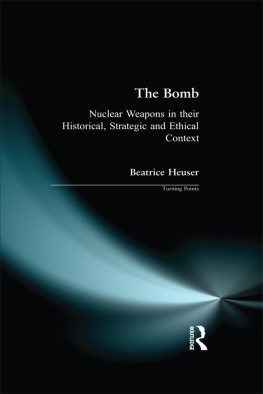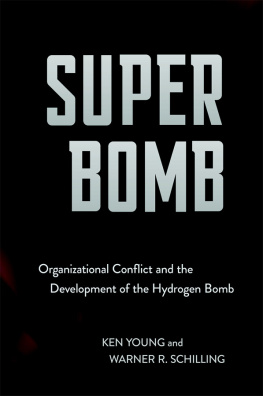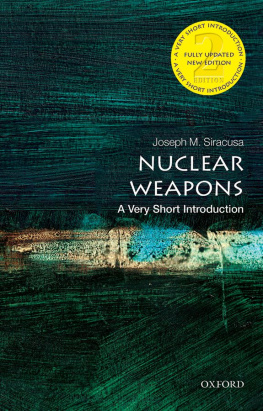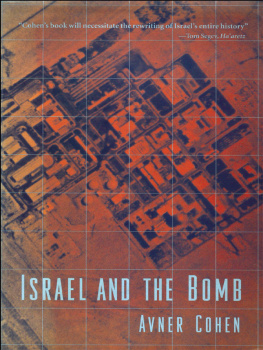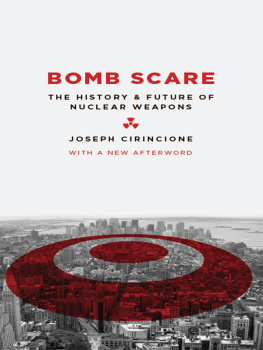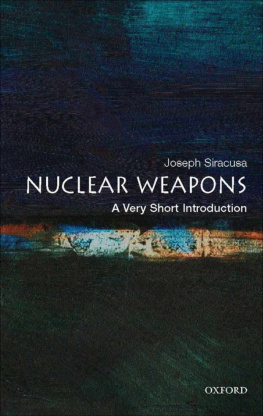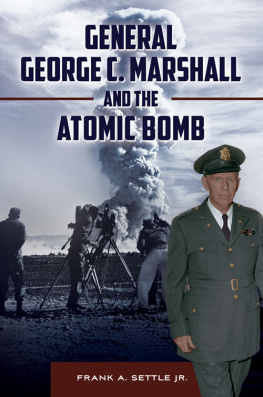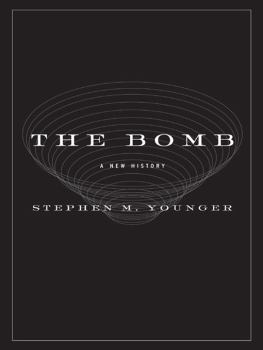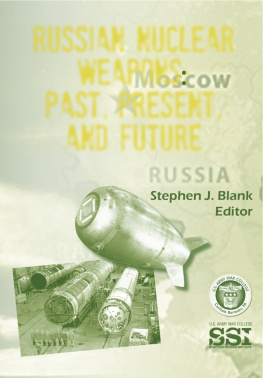John Wohlstetter - Sleepwalking with the Bomb
Here you can read online John Wohlstetter - Sleepwalking with the Bomb full text of the book (entire story) in english for free. Download pdf and epub, get meaning, cover and reviews about this ebook. City: Seattle, year: 2012, publisher: Discovery Institute Press, genre: Science / Non-fiction. Description of the work, (preface) as well as reviews are available. Best literature library LitArk.com created for fans of good reading and offers a wide selection of genres:
Romance novel
Science fiction
Adventure
Detective
Science
History
Home and family
Prose
Art
Politics
Computer
Non-fiction
Religion
Business
Children
Humor
Choose a favorite category and find really read worthwhile books. Enjoy immersion in the world of imagination, feel the emotions of the characters or learn something new for yourself, make an fascinating discovery.
- Book:Sleepwalking with the Bomb
- Author:
- Publisher:Discovery Institute Press
- Genre:
- Year:2012
- City:Seattle
- ISBN:978-1-93659-906-6
- Rating:4 / 5
- Favourites:Add to favourites
- Your mark:
- 80
- 1
- 2
- 3
- 4
- 5
Sleepwalking with the Bomb: summary, description and annotation
We offer to read an annotation, description, summary or preface (depends on what the author of the book "Sleepwalking with the Bomb" wrote himself). If you haven't found the necessary information about the book — write in the comments, we will try to find it.
Sleepwalking with the Bomb — read online for free the complete book (whole text) full work
Below is the text of the book, divided by pages. System saving the place of the last page read, allows you to conveniently read the book "Sleepwalking with the Bomb" online for free, without having to search again every time where you left off. Put a bookmark, and you can go to the page where you finished reading at any time.
Font size:
Interval:
Bookmark:
John C. Wohlstetter
SLEEPWALKING WITH THE BOMB
To family, friends, and others who educated me in coping with lifes challenges, including the challenge of thinking about how best to avoid man-made catastrophesof which nuclear conflict is most fearsome and destructive of all.

FOREWORD
Richard Perle
WHEN RICHARD NIXON RETURNED FROM MOSCOW IN 1972 HE brought with him the apparent triumph of a comprehensive agreement with Leonid Brezhnev that would end a nuclear weapons arms race and usher in a new era of constructive cooperation between the superpowers. Neither he, nor his grand strategist Henry Kissinger, understood that the ABM Treaty and separate offensive arms limitation agreements they negotiated would lead to a massive Soviet build-up that left the United States (and its allies) in a situation far worse than the one they hoped to improve.
Far from reducing the Soviets already vast nuclear arsenal, the agreements of 1972 actually increased both the number and lethality of Moscows nuclear forces. And they led directly to a challenge to the United States and its allies that was as grave as any in the Cold War.
The 1972 interim agreement fixed the number of launchers for nuclear armed intercontinental ballistic missiles, but it allowed for the enlargement of those launchers and the replacement of older, single warhead missiles by new missiles with multiple warheads. The Soviets promptly began to exploit both provisions of the agreement, first by replacing a class of missiles carrying a single warhead with a new class carrying three warheads. But not content with using an arms control freeze to triple the number of their warheads, they then proceeded to develop an entirely new missile, which was excluded from any limit because it lacked intercontinental range. The Soviets assigned this new missile (known as the SS-20) to the European targets that had been previously assigned missiles limited by the agreement. This freed up hundreds of missiles that could now be aimed at the United States. By the time Ronald Reagan took office in 1981, the SS-20 and NATOs plan to respond had created a crisis in the NATO alliance, as our allies debated whether to approve a plan to balance the new SS-20s with American missiles of comparable range. For much of Reagans first term the crisis dominated Americas relations with Russia and its NATO allies.
The unintended consequences of the 1972 arms agreement is but one example of a lesson that the Obama administration has yet to learn: arms control is seldom a solution but is often a problem. Today, the ill-founded belief that arms control treaties with Russia are vital to American interests militates against sensible policies regarding missile defense and nuclear weapons proliferation. By their nature, international treaties treat all signatories alike. Yet the great challenge of halting the proliferation of nuclear weapons will not be met until we accept that not all states or regimes are the same: nuclear weapons in the hands of Britain or France or the United States are not the same as nuclear weapons belonging to North Korea or Iran.
It was a misplaced global/legal sentiment that helped get us into todays situation where nuclear technology has been freely distributed around the world, waiting only for peaceful nuclear programs to be transformed into programs for nuclear weapons. The chances are that a future nuclear conflict will involve weapons acquired by one or more states that benefited from outside technical assistance based on, and justified by, the Atoms for Peace program and its progeny, the Nuclear Proliferation Treaty (NPT).
John Wohlstetter knows all this and a great deal more. With great clarity and effortless instruction he has astutely analyzed and explained the history and current issues surrounding nuclear weapons. Anyone wishing to understand the past, present and future of nuclear weapons should read this fine book before saying or writing a word on the subject. I cant think of a single journalist or government official, especially those with strong opinions on nuclear matters, who would not benefit from reading Sleepwalking With The Bomb. (The more they think they know, the greater the benefit.) But the thing most devoutly to be wished is that someone, somewhere in the Obama administration (and those that follow it) will read this important book.
RICHARD PERLE, WASHINGTON, D.C.PREFACE
THE IDEA FOR THIS BOOK CAME FROM WATCHING ADMINISTRATIONS make avoidable mistakes during the period after the end of the Cold War and the implosion of the former Soviet Union. There were things done right as well, but nuclear policy is supremely unforgiving, leaving little margin for error and little time to correct mistakes. Applying lessons from the failure to stop North Koreas nuclear quest, for example, would have led to better decisions and perhaps avoided the peril we confront today with Iran. This book draws lessons that I hope will give future leaders of the civilized world a better chance to make sound decisions.
A book of this nature necessarily involves some technical explanations and use of terms not universally familiar. I have done my best to make this material as clear as possible for nonspecialists; some clarifications and definitions are offered in the text itself, and some are in footnotes or in the books appendices.
The period covered in this book encompasses the last 46 years of the former Soviet Union (also known by the Anglicized initials USSR, or as Soviet Russia), and the first 20 years of its current remnant, Russia (known as the Russian Federated Soviet Socialist Republic, or RFSFR, when part of the USSR). Soviet Union and Russia were used colloquially during the Cold War period as interchangeable, and in the text the names are often alternated or combined, depending on context. The text also follows colloquial usage in referring to the United Kingdom as Britain or Great Britain or England.
Foreign names are spelled per usage familiar to the public; if I cite a text, I generally follow the spelling in the version cited. For Chinese names, I follow the modern, phonetic Pinyin system (thus Jiang Zemin); but I use the older Wade-Giles Roman transliteration for Taiwanese names (thus Chiang Kai-Shek).
I mined sources primarily for factual support for matters in the text, with analysis mine unless otherwise attributed. Where named people who have written memoirs are cited, their memoirs, if listed in the bibliography, are used as primary source material for what they said, wrote, or thought. Special attribution in the text is given to certain works unusual for their coverage of one or more parts of the puzzle, or for offering an especially valuable narrative. The text includes a bibliography of some of the more important works in the field, all of which were consulted in writing this book. Complete documentation of quotations and factual data is available online at www.SleepwalkingBomb.com.
As with any book, the author owes much to many. Bruce Chapman, founder and guide of Discovery Institute, created a home for me to think and writeat his insistence, in that order. His counsel on how best to proceed was invaluable, as was his editorial advice. Discoverys Steve Burie provided me with serial events at which to float my analyses and conclusions before a public audience.
George Gilder contributed the insights of his capacious, creative intellect, plus much encouragement and sage advice for the entire project. Others who read drafts and offered guidance and encouragement include Rosann Kaplin, Nicholas Fuhrman, Jack Oslund, and Tim Wilson. Tim brought his expert knowledge of weaponry to clear up key points. Edward Weidenfeld offered the sage advice drawn from his lifetime immersion in national security policy, politics, and history.
Font size:
Interval:
Bookmark:
Similar books «Sleepwalking with the Bomb»
Look at similar books to Sleepwalking with the Bomb. We have selected literature similar in name and meaning in the hope of providing readers with more options to find new, interesting, not yet read works.
Discussion, reviews of the book Sleepwalking with the Bomb and just readers' own opinions. Leave your comments, write what you think about the work, its meaning or the main characters. Specify what exactly you liked and what you didn't like, and why you think so.



